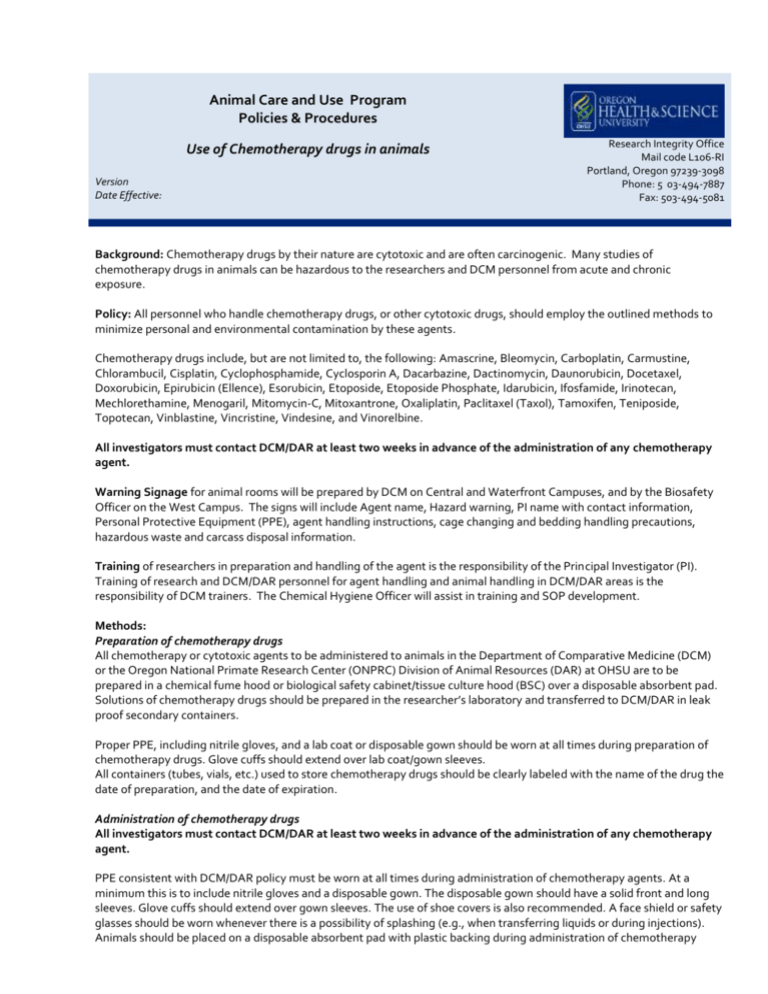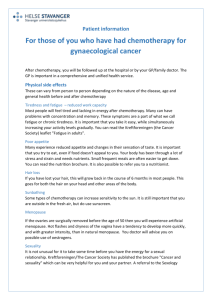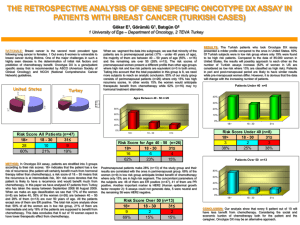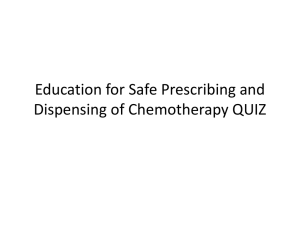Animal Care and Use Program Policies & Procedures Use of
advertisement

Animal Care and Use Program Policies & Procedures Use of Chemotherapy drugs in animals Version Date Effective: Research Integrity Office Mail code L106-RI Portland, Oregon 97239-3098 Phone: 5 03-494-7887 Fax: 503-494-5081 Background: Chemotherapy drugs by their nature are cytotoxic and are often carcinogenic. Many studies of chemotherapy drugs in animals can be hazardous to the researchers and DCM personnel from acute and chronic exposure. Policy: All personnel who handle chemotherapy drugs, or other cytotoxic drugs, should employ the outlined methods to minimize personal and environmental contamination by these agents. Chemotherapy drugs include, but are not limited to, the following: Amascrine, Bleomycin, Carboplatin, Carmustine, Chlorambucil, Cisplatin, Cyclophosphamide, Cyclosporin A, Dacarbazine, Dactinomycin, Daunorubicin, Docetaxel, Doxorubicin, Epirubicin (Ellence), Esorubicin, Etoposide, Etoposide Phosphate, Idarubicin, Ifosfamide, Irinotecan, Mechlorethamine, Menogaril, Mitomycin-C, Mitoxantrone, Oxaliplatin, Paclitaxel (Taxol), Tamoxifen, Teniposide, Topotecan, Vinblastine, Vincristine, Vindesine, and Vinorelbine. All investigators must contact DCM/DAR at least two weeks in advance of the administration of any chemotherapy agent. Warning Signage for animal rooms will be prepared by DCM on Central and Waterfront Campuses, and by the Biosafety Officer on the West Campus. The signs will include Agent name, Hazard warning, PI name with contact information, Personal Protective Equipment (PPE), agent handling instructions, cage changing and bedding handling precautions, hazardous waste and carcass disposal information. Training of researchers in preparation and handling of the agent is the responsibility of the Principal Investigator (PI). Training of research and DCM/DAR personnel for agent handling and animal handling in DCM/DAR areas is the responsibility of DCM trainers. The Chemical Hygiene Officer will assist in training and SOP development. Methods: Preparation of chemotherapy drugs All chemotherapy or cytotoxic agents to be administered to animals in the Department of Comparative Medicine (DCM) or the Oregon National Primate Research Center (ONPRC) Division of Animal Resources (DAR) at OHSU are to be prepared in a chemical fume hood or biological safety cabinet/tissue culture hood (BSC) over a disposable absorbent pad. Solutions of chemotherapy drugs should be prepared in the researcher’s laboratory and transferred to DCM/DAR in leak proof secondary containers. Proper PPE, including nitrile gloves, and a lab coat or disposable gown should be worn at all times during preparation of chemotherapy drugs. Glove cuffs should extend over lab coat/gown sleeves. All containers (tubes, vials, etc.) used to store chemotherapy drugs should be clearly labeled with the name of the drug the date of preparation, and the date of expiration. Administration of chemotherapy drugs All investigators must contact DCM/DAR at least two weeks in advance of the administration of any chemotherapy agent. PPE consistent with DCM/DAR policy must be worn at all times during administration of chemotherapy agents. At a minimum this is to include nitrile gloves and a disposable gown. The disposable gown should have a solid front and long sleeves. Glove cuffs should extend over gown sleeves. The use of shoe covers is also recommended. A face shield or safety glasses should be worn whenever there is a possibility of splashing (e.g., when transferring liquids or during injections). Animals should be placed on a disposable absorbent pad with plastic backing during administration of chemotherapy drugs. Cages containing animals that have been injected with chemotherapy drugs should be labeled in accordance with DCM/DAR policy. Cages should be labeled with a hazard warning sticker, the name of the chemotherapy agent administered, the date and time of injection, and contact information for the person responsible for the project, including an after hours number. Care of animals administered chemotherapy drugs PPE consistent with DCM/DAR policy must be worn at all times when handling animals injected with chemotherapy agents for at least 48 hr following administration, or until the bedding has been changed. At a minimum this includes nitrile gloves and a disposable gown. The disposable gown should have a solid front and long sleeves. Glove cuffs should extend over gown sleeves. The use of shoe covers, a surgical mask and a disposable hair cover is also recommended. A face shield or safety glasses should be worn whenever there is a possibility of splashing. The first bedding change after administration of chemotherapy agents should be performed in a BSC or an approved alternative. Bedding should not be changed until at least 48 hr after administration of chemotherapy agents or for the duration of hazard as determined by the IACUC risk assessment. PPE consistent with DCM/DAR policy should be worn at all times while bedding is being changed. At a minimum this includes nitrile gloves and disposable gown. Glove cuffs should extend over gown sleeves. The use of shoe covers is also recommended. If a BSC is not available, a fit-tested N-95 respirator must be worn. Cages of animals injected with chemotherapy agents should never be changed in a laminar flow clean bench, or other apparatus that blows air toward the operator. Nitrile gloves should be worn when handling empty cages, until they are washed, after the first bedding change following injection with chemotherapy agents, or after subsequent bedding changes for the duration of the hazard as determined by the IACUC risk assessment. Spills All spilled chemotherapy drugs should be cleaned up immediately using the procedure outlined below: Proper PPE (nitrile gloves, disposable gown and shoe covers) should be worn at all times during spill clean-up. Absorb as much of the spilled chemotherapy drug as possible with paper towels or absorbent pads. Clean the area thoroughly with soap and water, using additional paper towels. Disposal of waste DCM/DAR: Dispose of syringes and needles used for administering chemotherapy drugs in red sharps containers. DCM: Dispose of used gloves, gowns, shoe covers, absorbent pads, paper towels, and empty containers contaminated with chemotherapy drugs in a red biohazard bag. This bag should be sealed immediately and placed in a second red bag in a hazardous waste disposal container. Hazardous waste containers are disposed of under guidelines for infectious waste. o DAR: Contact Environmental Health & Radiation Safety/Research Safety Program (EHRS/RSP) for guidance regarding disposal. DCM: Dispose of used bedding directly into a red bio safety bag. This bag should be sealed immediately and placed in a second red bag in a hazardous waste disposal container. Hazardous waste containers are disposed of under guidelines for infectious waste. o DAR: Contact Environmental Health & Radiation Safety/Research Safety Program (EHRS/RSP) for guidance regarding disposal. DCM: Carcasses of all animals injected with chemotherapy agents should be placed in a red biohazard bag. This bag should be sealed immediately and placed in a second red bag in a hazardous waste disposal container. Hazardous waste containers are disposed of under guidelines for infectious waste. o DAR: Contact Environmental Health & Radiation Safety/Research Safety Program (EHRS/RSP) for guidance regarding disposal. DCM: Refer to the OHSU Health Care System Safety Manual or the OHSU Health Care System Patient Care Services Division - Nursing Policy and Procedure Manual (available on the OHSU Intranet) for more information on the safe handling of chemotherapy drugs.








